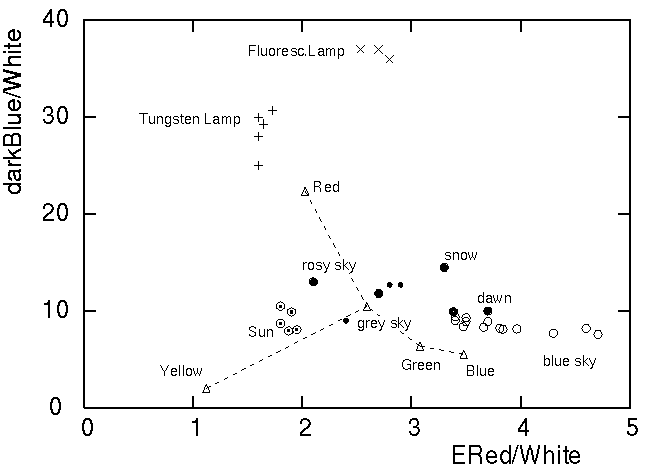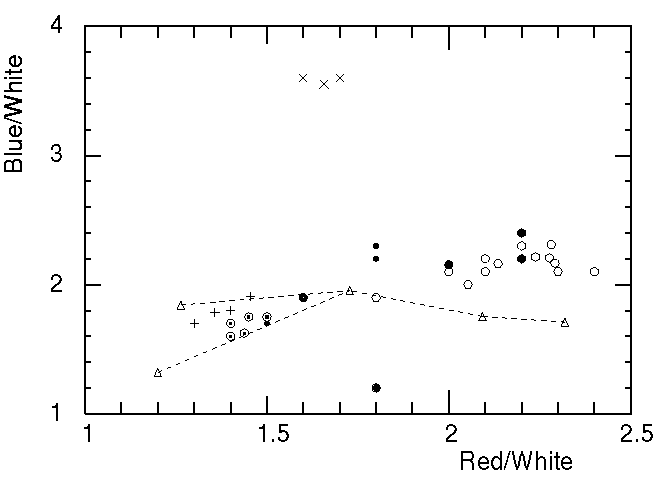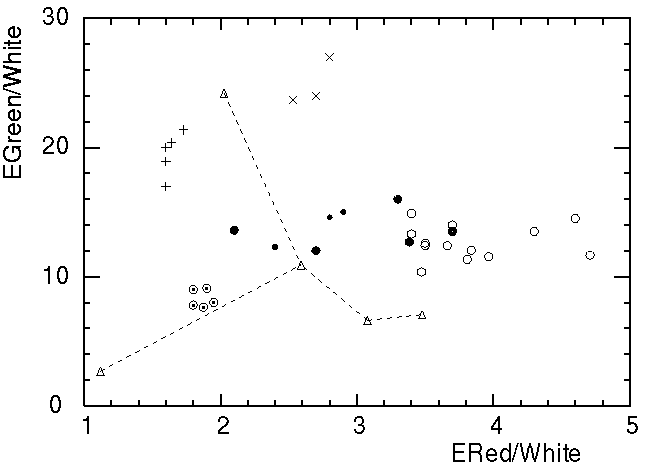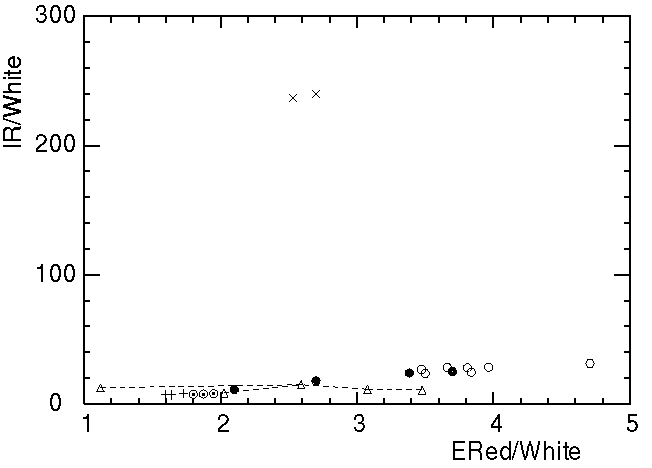
Tests and the Sky Over Kiel
Joachim Köppen DF3GJ Kiel/Strasbourg/Illkirch May 2004
In the table below, all resistances are given in kOhm.
| Source | White | ERed | EGreen | EBlue | Red | Yellow | Blue | darkBlue | IR |
| Tungsten Lamp | 1.1 | 1.9 | 23.5 | 4.4 | 1.6 | 1.4 | 2.1 | 33.8 | 9.0 |
| Fluorescent Lamp | 16.9 | 42.8 | 400 | 900 | 28 | 23 | 60 | 630 | 4000 |
| direct Sun | 0.016 | 0.030 | 0.122 | 0.60 | 0.023 | 0.020 | 0.026 | 0.127 | 0.120 |
| morning Sky | 3.7 | 14.2 | 44.0 | 40.5 | 7.9 | 5.7 | 8.0 | 30.0 | 90.5 |
| Snow | 1.0 | 2.7 | 12 | 7 | 1.8 | 1.47 | 2.16 | 11.8 | 17.7 |
| Dawn | 13.0 | 44 | 165 | 135 | 26 | 19 | 28 | 129 | 310 |
| blue Sky | 2.4 | 11.3 | 28 | 30 | 5.5 | 3.9 | 5.2 | 18.2 | 75 |
The following table shows more mesurements, but here all columns show already the ratio of the measured resistance and the 'white' resistance. Also, they have been arranged in order of increasing R_red/R_white. Note that the description in the first column gives simply my own impression.
| Source | White | ERed | EGreen | EBlue | Red | Yellow | Blue | darkBlue | IR |
| Tungsten Bulb | 1 | 1.6 | 20 | 3.9 | 1.4 | 1.2 | 1.8 | 30 | 7.9 |
| direct Sun | 1 | 1.8 | 9.0 | 3.8 | 1.4 | 1.2 | 1.7 | 10.5 | 7.4 |
| rosy Sky | 1 | 2.1 | 13.6 | 5.9 | 1.6 | 1.3 | 1.9 | 13 | 11 |
| Fluorescent Lamp | 1 | 2.7 | 24 | 53 | 1.6 | 1.4 | 3.6 | 37 | 240 |
| grey Sky | 1 | 2.8 | 14.6 | 7.4 | 1.8 | 1.5 | 2.2 | 12.7 | -- |
| white Sky | 1 | 2.9 | 15 | 7.8 | 1.8 | 1.5 | 2.3 | 12.7 | -- |
| Snow | 1 | 3.3 | 16 | 9.6 | 2.2 | 1.7 | 2.4 | 14.5 | -- |
| blue Sky | 1 | 3.5 | 12.6 | 10 | 2.1 | 1.6 | 2.2 | 9.3 | 23.5 |
| light blue Sky | 1 | 3.7 | 14 | 9.3 | 2.1 | 1.6 | 2.1 | 8.9 | -- |
| dawn Sky | 1 | 3.7 | 13.5 | 11 | 2.2 | 1.6 | 2.2 | 10 | 25 |
| deep blue Sky | 1 | 4.3 | 13.5 | 10.4 | 2.3 | 1.7 | 2.1 | 7.7 | -- |
| dark blue Sky | 1 | 4.6 | 14.5 | 10 | 2.4 | 1.7 | 2.1 | 8.2 | -- |
One can already see from the table, that the bluer the sky, the larger is the ratio R_red/R_white. This is very clear with the red gelatine filter (ERed), but also the poor red filter (Red) shows the same behaviour. neither the blue nor the green filter shows an equally clear trend.
What happens? For the white value, we measure the entire spectrum, and since in a blue sky the blue part is strong, it will make an important contribution. But when looked through the red filter, the strong blue part is absent, and therefore the resistance goes up. The more intense the blueness is, the darker the sky will appear in the red, and the larger the resistance will be.
Thus, for a measurement of the blueness of the sky, it would suffice to use only two photometers, one without a filter and the other with a good red filter. We use an additional blue channel to be able to discriminate between the colours in a more precise way:

The measurements Red, Yellow, Green and Blue refer to colour calibration cards illuminated by sunlight with a cloudless sky. All five symbols are connected to the measurement taken with White paper, in the centre. We note that the filter combination discriminates only weakly between blue and green, because the darkBlue filter also transmits some part of the green light.
Take for instance the Fluorescent Lamp in my kitchen. According to the Red channel, it is between the "rosy Sky" and what I termed "grey Sky", but to my eye it does have a distinctly blueish hue. The spectrum of the lamp is very different from that of the Sun or a Tungsten Bulb, because it consists of a number of emission lines, namely those of mercury. The spectrum of the Sun or an ordinary incandescent bulb shows a continuous spectrum, with all colours from red to blue and violet at comparable intensity. The resistances measured through the blue filters (EBlue or darkBlue) show that the Sun and the Tungsten Bulb give similar values, but the Fluorescent Lamp gives a much larger value, indicating a lack of intensity in the blue. Indeed the spectrum shows that despite the presence of a violet and a green emission line, there is also a strong red line. Evidently this makes an important contribution...
The combination of the simple Red and Blue filters is also not too bad, but we can no longer distinguish the sun from a tungsten lamp!

But the combination of ERed and EGreen also gives an excellent two-dimensional classification of colours. Maybe even among the blue sky measurements one sees genuine differences in hue.

Also one notices that the Fluorescent Lamp shines in the IR much less bright than either the Sun or the Tungsten Lamp. Thus it well deserves its name as 'cool light'. One is tempted to associate the lower cloud of data with continuous, black-body like spectra in contrast to the emission lines which dominate in the spectrum of fluorescent lamps ...

We decided to use three photometric channels, as it does give us the possibility do distinguish better between the colours, in case we wish or have the need to do so!
| Top of the Page | back to Main Page | back to my Home Page |